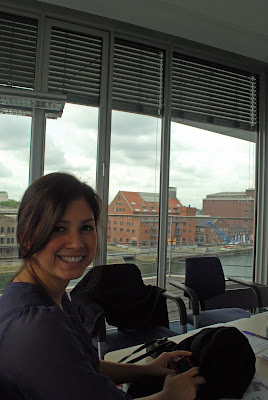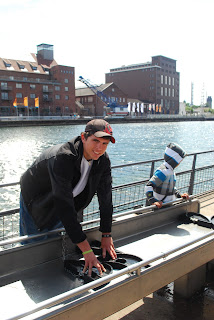After all the fun and exploration of the first week, the second week of B.E.S.T. brought the start of regular classes which from now on will comprise the bulk of the schedule. We are here to learn after all. Classes are in the usual 2.5 hour summer block format with one morning course and another after lunch. The room is un air-conditioned, but that’s common here in Europe. Fortunately the wet weather, while not great for extracurricular travel and sightseeing, has so far keep temperatures down during the day.
This first week consisted of introductory lessons in a variety of subjects. In total we will be attending seven courses during the 5 weeks of B.E.S.T. On Monday, we attended lectures on “International Marketing from a European Perspective” with Dr. Andreas Klein and “European Economic Integration” with Sven Horak. Tuesday, we attended another German lesson as well as another section of European Economic Integration. Wednesday, however, we had a change of pace with a field trip to the Duisburg-based IT consulting company “cundus AG” (the lower-case ‘c’ is correct).
 |
| cundus AG headquarters near Innerhafen district, Duisburg |
Cundus AG was founded by Profesor Dr. Peter Chamoni who is the current chairman of the board. The main office is located in the Innerhafen district where some of us had visited and eaten lunch the previous week. The morning drive was quite interesting; Frau Heusner has been replaced at the steering wheel by another Kanu-Club employee who was not quite sure of the route and spent most of the drive swearing and generally abusing the van’s clutch. At one point we even took a wrong turn and crossed over the River Rhine! Somehow, we arrived intact and were greeted by Malte and Prof. Dr. Chamoni.
 |
| Clo enjoys the view of the Innerhafen from the cundus AG offices. |
Prof. Dr. Chamoni spent the morning explaining the company to us. Cundus AG was founded with the goal of designing new software which was capable of running with SAP products. SAP is a German-based world-leader in enterprise software with its best-known products being SAP Enterprise Resource Planning (SAP ERP) and SAP BusinessObjects software. Basically, Cundus AG designed a program to help businesses comply with new European financial disclosure laws by compiling financial records electronically. The program was either licensed or sold to SAP which incorporated it into the firm’s BusinessObjects tools. Cundus AG now acts as a consultant for its product, helping firms around the world use SAP BusinessObjects software and tailoring to own product to its customers’ needs. It’s all fairly complicated, but the point is that very few people in the world understand enough about this software to really work with it, and Cundus employees, being among that select group, are quite well-compensated for their skills.
The afternoon session was led by a Cundus AG programmer named Jens Panzer who offered a breakdown of the theoretical aspects of the company’s software. Sensing that we weren’t quite following all of the technical jargon, he was nice enough to fire up a demo version of the software and demonstrate some of the possible real-world applications.
During the evenings, some of the students and I ventured out on bikes to further explore the neighborhood called Wanheimerort where the Wanheimer Kanu-Club is located. One excursion led to a delicious pizza/Indian restaurant while another led to us eating döner in the Turkish neighborhood north of the WKC. Between classes and my brief lessons, the other students are learning simple German phrases. However, I´m generally still called upon to read menus and order food at mealtime. I´ve made a point of asking for and learning the names of the most common items in cafes. Döner, for instance, is a Turkish dish of rotisserie-cooked lamb or beef (served in a similar manner to gyros or shawarma). I can´t recommend it highly enough!
Thursday was a federal holiday in German: Das Fronleichnamsfest, or Corpus Christi. Typically a religious feast day, it is celebrated as a public holiday in many states in Germany. This meant that the university campus would be closed, so the day´s German class would be held at the Kanu-Club instead. Over seven hours we practiced numbers, how to shop, and how to order in a restaurant. We also met another exchange student Charles Guo from Princeton who is conducting scientific research at Uni Duisburg-Essen. His German is quite good, but he may join our classes from time to time throughout the summer.
 |
| Kit Ying, Mian Mian, and Meruyert play clerks in our German lesson "At the Store". |
 |
| Beatrix Fesle (standing) leads the German language class at the Kanu-Club during the federal holiday. Visiting Princeton student Charles Guo is 2rd from left (seated). |
Late Thursday evening Malte, Jörn, and their girlfriends took us to visit the popular tourist attraction Landschaftspark Nord, an old industrial park north of the city which has been converted into a sort of open-air museum to industrial culture and heritage. The park is open 24/7 and visitors can explore old factories, climb blast furnaces, and scuba dive in Europe´s largest artificial diving center (a converted gas storage tank). Outdoor concerts and film festivals also occur throughout the warmer months. Our guide for the evening was Andreas Meyer, a very typical German name as he was fond of pointing out. Andreas was very enthusiastic about the park and its mission of preserving the Ruhr area´s industrial heritage for future generations. Highlights of the tour included climbing 70m to the summit of the No. 5 blast furnace and sliding down a long, winding chute into a 45ft-deep former storage pit for the iron and coal that once fueled these massive machines. The blast furnace itself ran 24/7 on 12 year cycles, shutting down only to cool off for three months so that workers could climb inside and replace the interior brick shielding! Art installations and recreational features like climbing walls are scattered among the buildings and factory equipment which has been otherwise undisturbed.
Stay tuned for more! Coming soon, Weekend Trip to Amsterdam!



















